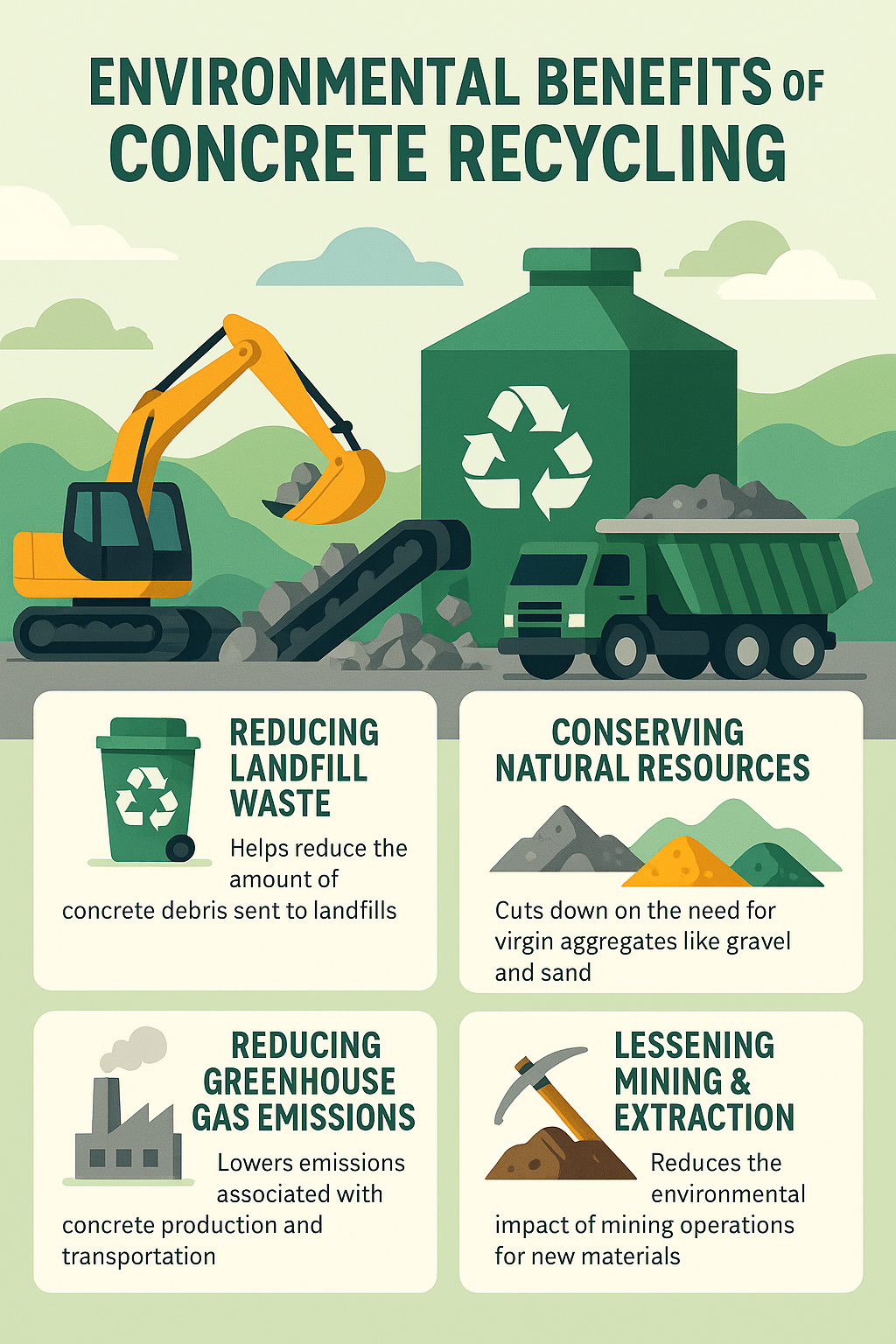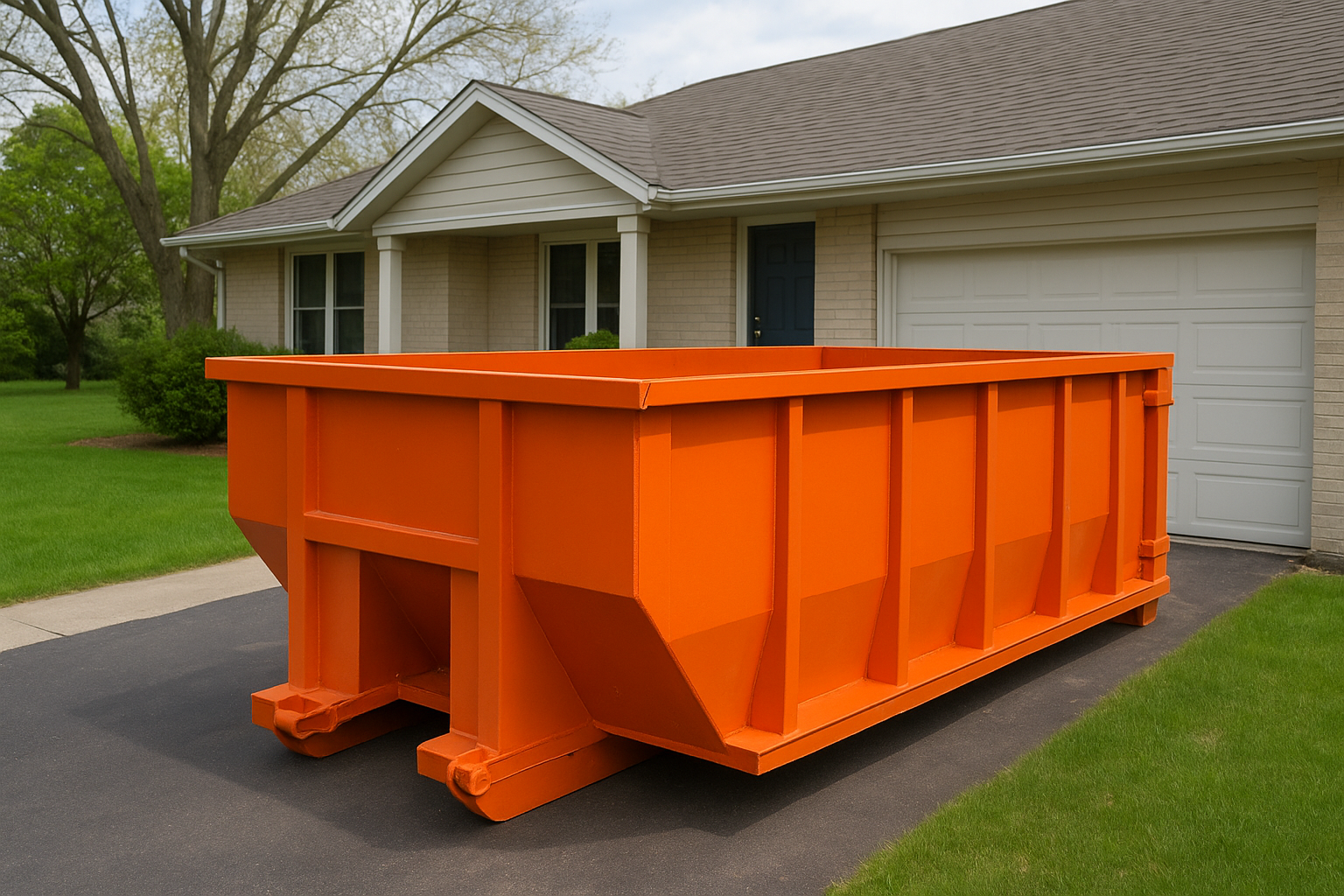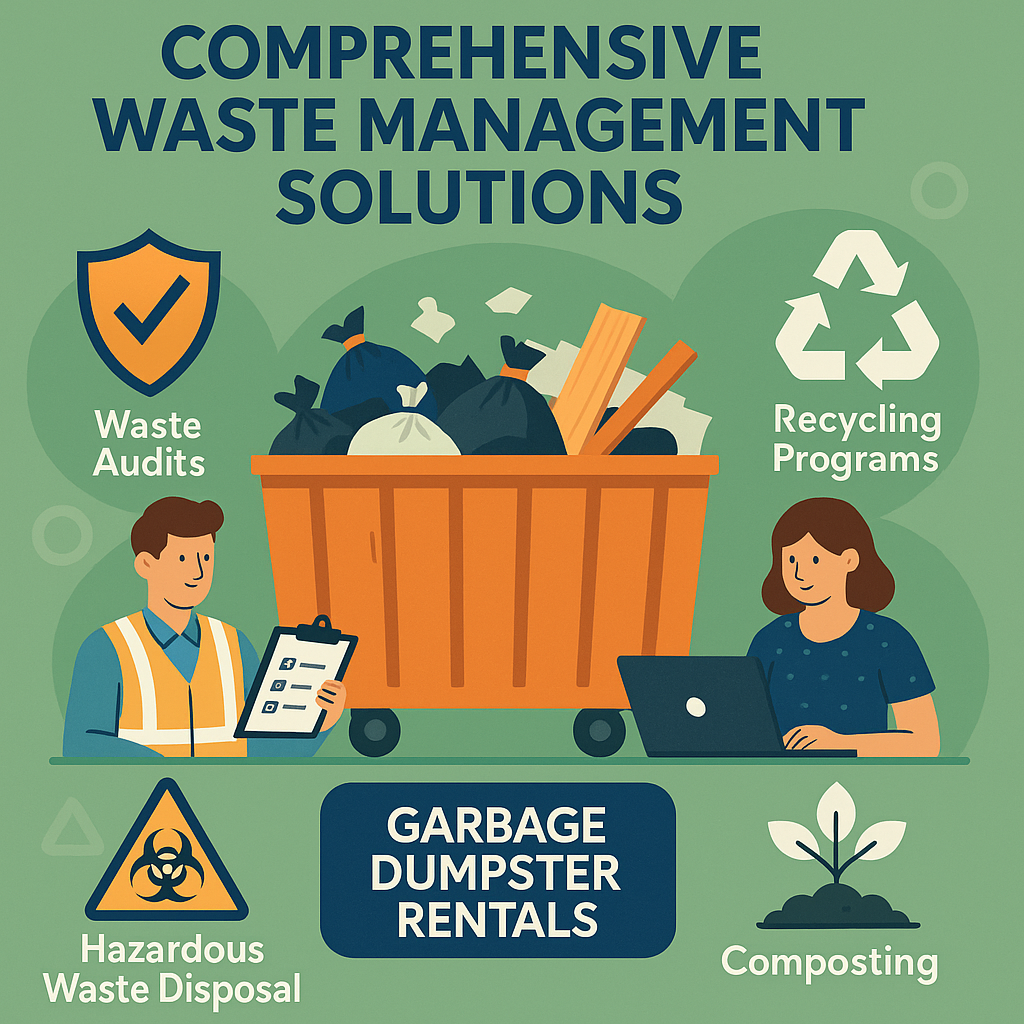
Environmental Benefits of Concrete Recycling: A Greener Path to Construction Waste Management
By BKThemes
Introduction to Concrete Waste in Construction
Concrete Waste: A Growing Environmental Challenge
Concrete is the most widely used construction material in the world—and one of the most waste-generating. Construction and demolition (C&D) projects account for nearly 600 million tons of waste annually in the U.S. alone, with concrete making up over half of that volume.
Traditional Disposal vs. Recycling
Traditionally, concrete debris is hauled to landfills, a process that:
-
Consumes fossil fuels
-
Occupies precious landfill space
-
Disrupts ecosystems near disposal sites
Recycling presents a better alternative by transforming concrete into reusable aggregate for future construction.
The Role of Waste Management in the Built Environment
Modern waste management services facilitate concrete recycling through:
-
On-site segregation
-
Transportation via garbage dumpster rentals
-
Delivery to crushing and screening facilities
These efforts support a closed-loop construction cycle, aligning with green building principles and environmental goals.
What is Concrete Recycling?
The Concrete Recycling Process
Concrete recycling involves:
-
Collection of debris from demolition or site preparation
-
Crushing the concrete using specialized machinery
-
Screening and removal of contaminants (e.g., rebar, plastic)
-
Producing recycled concrete aggregate (RCA) for reuse
Equipment Used in Crushing and Screening
Recycling facilities use:
-
Mobile crushers
-
Impact crushers
-
Jaw crushers
-
Vibrating screens
These machines ensure that the recycled material is clean, graded, and ready for future use.
Where Recycled Concrete Is Used
Common applications include:
-
Road base and sub-base
-
Pipe bedding
-
Parking lots and sidewalks
-
Foundations and structural fill
Using recycled concrete reduces the demand for virgin materials, helping preserve natural landscapes.
Key Environmental Benefits of Concrete Recycling
Reducing Landfill Use and Overcrowding
One of the most direct environmental benefits of concrete recycling is the reduction of landfill waste{:rel=“nofollow noopener”}. Landfills are rapidly reaching capacity, and concrete occupies significant space due to its density and bulk. By recycling, contractors:
-
Preserve valuable landfill space
-
Reduce tipping fees
-
Lower transportation costs
Using waste dumpster rental{:rel=“nofollow noopener”} services designed for concrete ensures this material is properly diverted to recycling centers instead of dumped as general refuse.
Conserving Natural Resources
Concrete is composed of sand, gravel, and crushed stone—all of which require quarrying. These extraction processes:
-
Degrade landscapes
-
Consume energy
-
Destroy habitats
Waste management companies that offer waste management dumpster rentals for recycling allow builders to reuse concrete rather than depend on new raw materials, preserving the earth’s limited resources.
Decreasing Greenhouse Gas Emissions
Every stage of concrete production—from mining to transport to disposal—emits greenhouse gases (GHGs). Recycling concrete lowers emissions by:
-
Reducing the energy required to extract and process virgin materials
-
Minimizing landfill methane release
-
Shortening transportation distances
When combined with smart logistics from national waste disposal{:rel=“nofollow noopener”} providers, concrete recycling significantly contributes to climate action goals.
How Garbage Dumpster Rentals Support Recycling Efforts
Segregation at the Source
Recycling starts on the job site. Garbage dumpster rentals{:rel=“nofollow noopener”} provide contractors with dedicated containers to separate concrete from other waste materials like wood or metal. This improves recycling purity and efficiency downstream.
Choosing the Right Dumpster Size for Concrete
Concrete is heavy and dense. Selecting the proper size from garbage dumpster rentals providers ensures:
-
Safe transport
-
Cost control by avoiding overweight penalties
-
Efficient pickup scheduling
Typical dumpster sizes for concrete include:
-
10-yard dumpsters (ideal for small to medium projects)
-
20-yard dumpsters{:rel=“nofollow noopener”} (suitable for larger demolition jobs)
Safe Transportation of Heavy Debris
Waste management companies{:rel=“nofollow noopener”} are equipped to transport heavy loads. Their roll-off trucks and trained staff ensure debris reaches recycling plants safely and legally—complying with Department of Transportation weight limits and safety protocols.
Role of Waste Dumpster Rental in Concrete Recovery Projects
Temporary Dumpsters for Demolition Sites
Demolition projects generate large quantities of concrete in a short period. Waste dumpster rental{:rel=“nofollow noopener”} services provide temporary roll-off bins delivered and removed on demand. This keeps the job site clean and compliant with local regulations.
Permanent Solutions for Ongoing Projects
For contractors with long-term construction projects, waste management dumpster rental{:rel=“nofollow noopener”} plans can include regularly serviced bins dedicated to concrete recycling. This ensures consistent waste tracking and environmental responsibility.
Scheduling Pickups for Efficient Workflows
Pickup timing is critical on busy sites. Efficient scheduling minimizes:
-
Downtime from overflowing bins
-
Safety hazards
-
Delays in material staging
Many providers now offer online scheduling tools and automated reminders for optimal coordination.
Waste Management Dumpster Rentals for Sustainable Construction
Streamlining Concrete Collection
By centralizing concrete debris in clearly labeled waste management dumpster rentals, job sites:
-
Reduce the risk of contamination
-
Increase the speed of collection
-
Simplify the loading process for haulers
This improves both operational efficiency and environmental compliance.
Sorting Waste for Recycling Facilities
Upon arrival at a recycling facility, concrete from dedicated dumpsters is:
-
Screened for contaminants
-
Crushed into standardized sizes
-
Graded for structural or non-structural reuse
Proper sorting at the source leads to cleaner output and greater sustainability.
Reducing Illegal Dumping on Job Sites
Without proper disposal options, some contractors resort to illegal dumping—which can lead to:
-
Fines
-
Legal liability
-
Environmental damage
Waste management services offering affordable and timely dumpster rentals{:rel=“nofollow noopener”} reduce the likelihood of such violations.
Waste Management Companies and Concrete Recycling Programs
Services Offered for Concrete Disposal
Top waste management companies{:rel=“nofollow noopener”} provide:
-
Specialized concrete dumpster delivery
-
On-site waste audits
-
End-of-project recycling reporting
They also help businesses comply with EPA and state environmental guidelines.
Partnering for LEED and Green Certification
LEED-certified buildings earn points for recycling materials like concrete. Waste management services support these efforts with:
-
Documentation of diverted materials
-
Tonnage tracking reports
-
Guidance on proper dumpster use
This helps contractors meet green building benchmarks and enhance their sustainability image.
Tracking and Reporting Environmental Metrics
Transparency is key to modern sustainability. Many waste management companies{:rel=“nofollow noopener”} now offer client dashboards that track:
-
Diversion rates
-
Carbon savings from recycling
-
Number of dumpster pickups vs. emissions generated
Advantages of Concrete Recycling in National Waste Disposal Efforts
Nationwide Resource Conservation
Across the U.S., national waste disposal{:rel=“nofollow noopener”} strategies now emphasize conservation of raw materials. Recycling concrete plays a major role by:
-
Reducing dependence on quarries for new gravel and sand
-
Limiting energy consumption at the national level
-
Supporting sustainable infrastructure development
This nationwide approach encourages contractors, developers, and municipalities to adopt waste management dumpster rentals{:rel=“nofollow noopener”} designed for clean debris collection.
Alignment with Government Sustainability Goals
Agencies like the EPA and U.S. Green Building Council advocate for concrete recycling as part of broader goals to:
-
Reduce landfill contributions
-
Lower carbon emissions
-
Promote a circular economy
Waste management companies that align with these initiatives gain access to public contracts, funding opportunities, and environmental awards.
Enhancing Infrastructure Through Reuse
Recycled concrete is used in:
-
Federal highway projects
-
Local road resurfacing
-
Military base construction
It offers a cost-effective and sustainable material source, ensuring long-term durability with a smaller environmental footprint.
Greenhouse Gas Reductions Through Recycled Concrete Use
Energy Savings from Reduced Processing
Producing new concrete involves:
-
Extracting raw materials
-
Transporting aggregates
-
Mixing and curing
Recycling skips several of these steps, resulting in major energy savings. Recycled concrete aggregate (RCA) often requires only crushing and minimal processing.
Lower Transportation Emissions
Many waste management companies offer regional recycling centers, reducing travel distance for hauling concrete debris. Combined with efficient waste dumpster rental{:rel=“nofollow noopener”} logistics, this greatly cuts diesel use and associated emissions.
Supporting Climate-Friendly Construction
Using recycled concrete helps builders:
-
Lower embodied carbon in their structures
-
Qualify for green certifications
-
Appeal to environmentally conscious clients
When paired with smart garbage dumpster{:rel=“nofollow noopener”} strategies, recycling becomes a cornerstone of low-impact construction.
Reducing Resource Extraction with Recycled Concrete
Avoiding Quarry Mining and Habitat Destruction
Quarrying damages landscapes and displaces ecosystems. Recycled concrete:
-
Replaces the need for virgin materials
-
Reduces demand for new quarries
-
Preserves biodiversity near resource-rich regions
Preserving Gravel and Sand Reserves
Global demand for sand is outpacing natural replenishment. RCA helps extend the life of existing gravel and sand reserves by acting as a substitute in numerous applications.
Replacing Virgin Aggregates in Concrete Mixes
Innovative concrete mixes use RCA to maintain strength while:
-
Lowering costs
-
Increasing sustainability
-
Meeting performance standards for a wide range of uses
Economic Benefits Tied to Environmental Gains
Lower Disposal Costs with Dumpster Rentals
Hauling concrete to a landfill is expensive. By using garbage dumpster rentals{:rel=“nofollow noopener”} that prioritize recycling:
-
Contractors reduce tipping fees
-
Avoid penalties for landfill overuse
-
Save on transportation costs
Cost Savings in Recycled Aggregate Procurement
RCA is often 20–30% cheaper than virgin material. Builders can use it in:
-
Foundations
-
Road bases
-
Drainage layers
These cost savings add up significantly over multiple projects.
Incentives for Sustainable Practices
Many states and municipalities offer:
-
Rebates for recycling over landfill use
-
Tax deductions for green building practices
-
Credits toward sustainability certifications (LEED, BREEAM)
Working with environmentally focused waste management services{:rel=“nofollow noopener”} ensures eligibility for these benefits.
How to Ensure Your Waste Management Services Are Eco-Conscious
Choosing Green Providers
Look for waste management companies that:
-
Offer recycling-specific dumpster rentals
-
Track environmental impact data
-
Employ eco-friendly transportation methods
Evaluating Environmental Certifications
Certifications to look for:
-
ISO 14001 (Environmental Management)
-
LEED Accredited Professional support
-
State-issued recycling operation licenses
These confirm the provider’s commitment to sustainability.
Asking the Right Sustainability Questions
Before hiring, ask:
-
What percentage of my concrete waste will be recycled?
-
Do you provide end-of-project diversion reports?
-
Are your dumpsters tracked for optimization?
-
Can you help us achieve LEED points?
A provider willing to answer these questions transparently is likely a solid sustainability partner.
Case Studies: Projects That Benefited from Concrete Recycling
Urban Development and Road Work
In Chicago, a city-led initiative recycled over 1 million tons of concrete from roadwork and sidewalk demolition, saving $3.5 million in landfill fees and significantly reducing emissions.
Large Commercial Demolition Projects
A retail chain remodeling 50+ locations used waste management dumpster rentals{:rel=“nofollow noopener”} to separate concrete on-site. They achieved an 85% diversion rate and reduced project timelines by 20%.
Community Revitalization and Sidewalk Repairs
In Portland, neighborhood sidewalk repairs used 100% recycled concrete aggregate, saving local government $60,000 and preserving green space by avoiding quarry expansion.
Common Myths About Concrete Recycling Debunked
Is Recycled Concrete Weaker?
No. When processed correctly, recycled concrete can match or even exceed the performance of virgin material for many applications, including structural uses.
Can It Be Used for Structural Projects?
Yes. Recycled concrete is often used in:
-
Bridge abutments
-
Foundation slabs
-
Reinforced pavements
It must meet ASTM and ACI standards, but modern recycling techniques make this achievable.
Is Recycling Concrete Too Expensive?
On the contrary, it’s often more affordable. Savings come from:
-
Lower disposal costs
-
Reduced material procurement expenses
-
Fewer environmental compliance fines
Tools and Technologies Enhancing Concrete Recycling
Mobile Crushers and On-Site Screening
Portable crushers allow on-site processing of concrete, reducing:
-
Transportation costs
-
Noise pollution
-
Dust from offsite hauling
These are ideal for large demolition sites or remote projects.
Smart Dumpsters and Fill Monitoring
High-tech waste management dumpster rentals{:rel=“nofollow noopener”} now feature:
-
IoT sensors to detect fullness
-
Automated pickup notifications
-
Overload alerts to prevent extra charges
AI in Sorting and Waste Tracking
AI systems at recycling facilities:
-
Improve sorting accuracy
-
Speed up processing
-
Provide data analytics to track performance
This ensures contractors meet recycling targets while minimizing costs.
FAQs About Concrete Recycling and Waste Management
Q1: What size dumpster do I need for concrete?
Typically, a 10-yard dumpster is ideal for heavy materials like concrete due to weight restrictions.
Q2: Where does recycled concrete go?
To facilities where it’s crushed and reused as road base, fill material, or new concrete mix components.
Q3: Can I mix concrete with other waste?
It’s not recommended. Clean, uncontaminated concrete ensures better recycling outcomes and may lower disposal fees.
Q4: Is concrete recyclable in all states?
Yes, though availability of facilities and regulations may vary. Always consult local waste management services.
Q5: How do I find a waste management provider?
Search for certified waste management companies with strong sustainability records, positive reviews, and recycling-focused services.
Q6: What are tipping fees for concrete?
They vary by region, but recycling often incurs lower fees than landfill disposal.
Conclusion: Concrete Recycling as a Pillar of Sustainable Waste Management
Concrete recycling is no longer just a responsible choice—it’s a strategic one. By using waste dumpster rental solutions and partnering with eco-focused waste management companies, contractors and municipalities:
-
Reduce landfill use
-
Lower greenhouse gas emissions
-
Conserve natural resources
-
Cut costs while improving environmental performance
As national waste disposal programs evolve, concrete recycling stands as a powerful way to build sustainability into every project.
Now’s the time to embrace the benefits—both environmental and economic—of concrete recycling. Partner with the right garbage dumpster provider and pave the way for greener construction.



